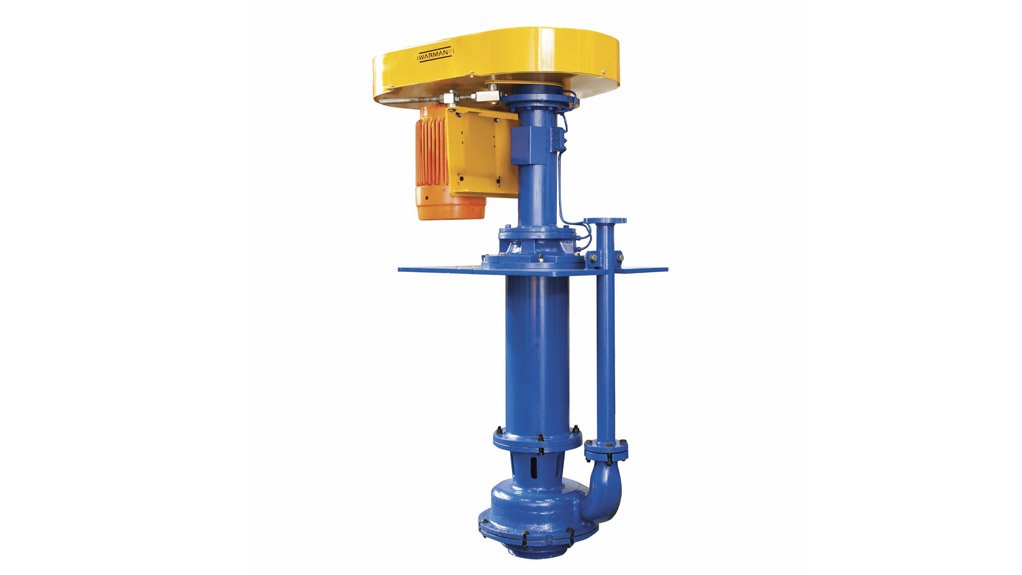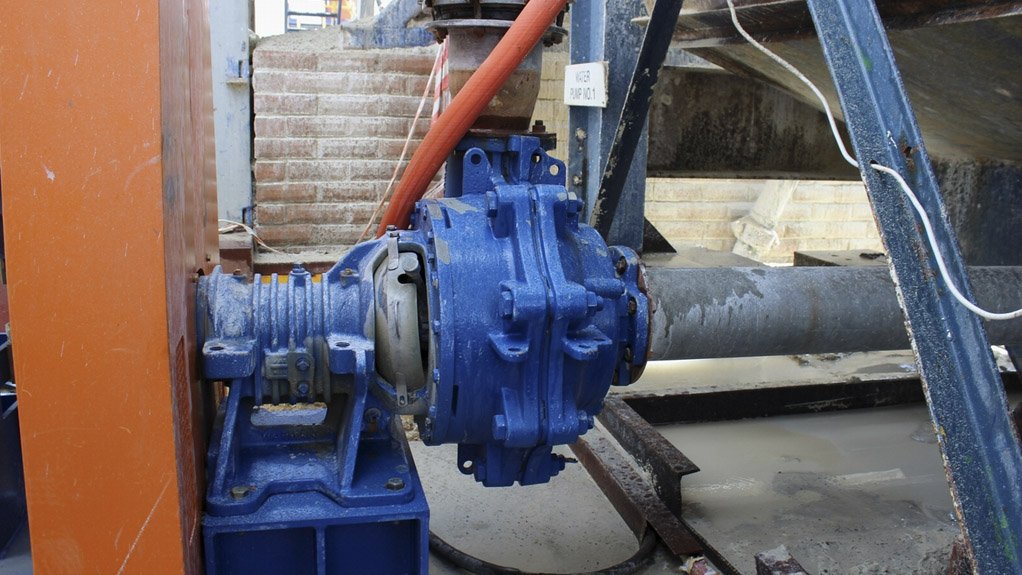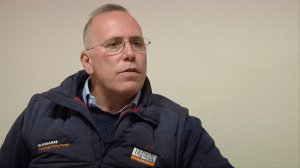New pump designs improve longevity, reduce costs



Weir Minerals Africa and Middle East sales and marketing director Rob Fawcett discusses the company’s new pump designs. Camerawork: Nicholas Boyd. Editing: Lionel da Silva.
WARMAN WBV VERTICAL PUMP This technology can be retrofitted to manage the build-up of solids in a sump pump
WARMAN WBH SLURRY PUMP The advancement of the Warman AH pump features single-point adjustment and wear reduction technology
With the global mining industry facing a challenging commodities price decline, industrial equipment supplier Weir Minerals has developed pump designs that offer improved cost effectiveness and a greater life span.
Cost effectiveness is a key driver of Weir’s product development, which enables the company to help mines improve their overall plant efficiency, extend their lives and continue operating in difficult times, says Weir Minerals Africa and Middle East sales and marketing director Rob Fawcett.
“Our focus is on balancing cost with longevity and energy efficiency,” he adds.
Last year, Weir Minerals introduced a range of Warman WBV heavy-duty vertical cantilevered slurry pumps for sump pump applications. These can be retrofitted to manage the build-up of solids in a sump and reduce the mess caused by spillages in a plant. Fawcett notes that when there is no cutoff mechanism in a sump pump application, solids can build up in the sump, as a result of its continued operation at low water levels.
He notes that external agitators used on submersible pumps have proven to be costly and only partially successful in managing this problem, as they often wear and cease to be effective when working in a bogged condition with a high concentration of solids. Weir developed a design that integrates the agitator into the impeller of the pump so that the impeller diverts a certain amount of the inlet flow through the pump to agitate the solids. “In this way, the unit is able to de-bog the sump, even with a relatively high concentration of solids, which standard sump pumps are unable to operate in,” he adds.
The company has also improved the original design of its Warman AH centrifugal slurry pump – a benchmark product in the slurry pumping market for more than 40 years, according to Fawcett. This resulted in the development and launch of its Warman WBH pump, which Weir says offers market leading single-point adjustment technology.
Fawcett explains that a significant improvement in the wear life of a pump unit can be achieved simply by rotating the throatbush – which links the intake of the pump to the volute and forms a pump chamber in which the impeller operates. He notes that, in the past, the unit would have to be stripped down to rotate the throatbush and then reassembled. However, Weir’s Warman WBH unit features a single nut on the cover plate that moves the throatbush rotationally and axially through a one-quarter turn and this adjustment can be achieved while the pump is in operation.
This feature allows the gap between the impeller and throatbush to be adjusted while simultaneously rotating the throatbush. Fawcett highlights that decreasing this gap improves the pump’s efficiency, subsequently reducing the amount of slurry recirculation down the front side of the impeller and extending the wear performance of the pump. “The bigger the gap between impeller and throatbush, the more recirculation of slurry, wearing the unit at a higher rate,” he explains.
Wear on the pump is also distributed more evenly by rotating the throatbush, extending the life of the throatbush and impeller by between 15% and 30%.
Weir also improved the impeller design, resulting in a reduction in wear and an improvement in the efficiency of the pump. This WRT technology, at conservative estimates, improves the efficiency of the unit by between 2% and 5%, compared with units which do not employ WRT technology. Fawcett notes that the degree of improvement is highly dependent on the unit’s application, with factors, such as particle size, particle shape, slurry densities, concentration by weight and the pumping environment, influencing the success of the technology. He highlights that a significant improvement in the performance of the pump has been demonstrated in some tests with clients.
A more robust and rigid one-piece bearing-frame design also ensures the correct alignment of bearings, the seal and impeller to the front liner. This prevents corrosion between components, improving the life of the unit’s bearings. The design also lowers energy and water consumption, allows for easy maintenance and incorporates various safety features that reduce the risk of unit failure; it also decreases shaft deflection, vibration and wear on the seal area.
Weir Minerals also offers heavy-duty rubber-lined pumps for mill pumping circuits, under its Warman MCR range. These pumps, it says, are fast gaining traction in the industry as a successful alternative to traditional metal pumps in mill applications. “Weir Minerals broke protocol in this industry with the introduction of the rubber-liner option 15 years ago. “However, mill pumping is quite an aggressive application and metal pumps are no longer thought to be the only option,” Fawcett declares.
He notes that the rubber-liner option has significant cost benefits, as it extends the intervals required between maintenance services. This reduces mill downtime, which improves operational efficiency and reduces maintenance costs.
“We have a number of material options available for these pumps and, when combined with their design, we have been able to put some distance between ourselves and our competitors when it comes to mill pumps. Over 80% of mill pumps applications can be performed using this technology.”
Fawcett stresses that, through these product developments, Weir has sought to offer its clients inventive solutions for each aspect of the mining industry’s pumping processes. Moreover, the company is conducting research and development into tailings applications and trialling new impeller designs at mines in South Africa to improve the efficiency of tailings systems. “We will continue to invest in our products to ensure our clients receive the very best that technology and material science has to offer,” says Fawcett.
Article Enquiry
Email Article
Save Article
Feedback
To advertise email advertising@creamermedia.co.za or click here
Press Office
Announcements
What's On
Subscribe to improve your user experience...
Option 1 (equivalent of R125 a month):
Receive a weekly copy of Creamer Media's Engineering News & Mining Weekly magazine
(print copy for those in South Africa and e-magazine for those outside of South Africa)
Receive daily email newsletters
Access to full search results
Access archive of magazine back copies
Access to Projects in Progress
Access to ONE Research Report of your choice in PDF format
Option 2 (equivalent of R375 a month):
All benefits from Option 1
PLUS
Access to Creamer Media's Research Channel Africa for ALL Research Reports, in PDF format, on various industrial and mining sectors
including Electricity; Water; Energy Transition; Hydrogen; Roads, Rail and Ports; Coal; Gold; Platinum; Battery Metals; etc.
Already a subscriber?
Forgotten your password?
Receive weekly copy of Creamer Media's Engineering News & Mining Weekly magazine (print copy for those in South Africa and e-magazine for those outside of South Africa)
➕
Recieve daily email newsletters
➕
Access to full search results
➕
Access archive of magazine back copies
➕
Access to Projects in Progress
➕
Access to ONE Research Report of your choice in PDF format
RESEARCH CHANNEL AFRICA
R4500 (equivalent of R375 a month)
SUBSCRIBEAll benefits from Option 1
➕
Access to Creamer Media's Research Channel Africa for ALL Research Reports on various industrial and mining sectors, in PDF format, including on:
Electricity
➕
Water
➕
Energy Transition
➕
Hydrogen
➕
Roads, Rail and Ports
➕
Coal
➕
Gold
➕
Platinum
➕
Battery Metals
➕
etc.
Receive all benefits from Option 1 or Option 2 delivered to numerous people at your company
➕
Multiple User names and Passwords for simultaneous log-ins
➕
Intranet integration access to all in your organisation



















